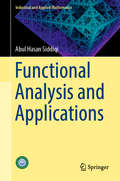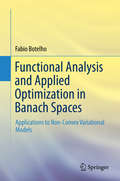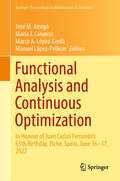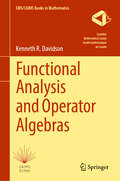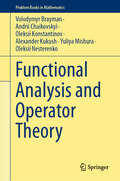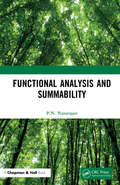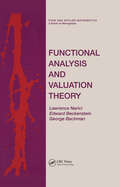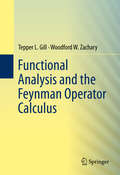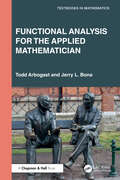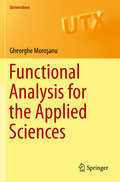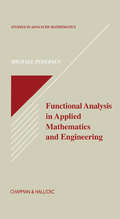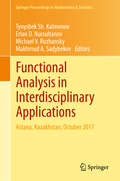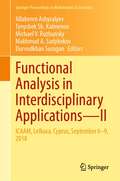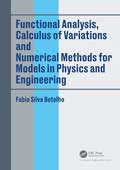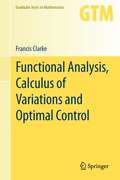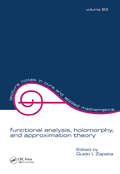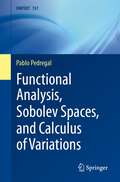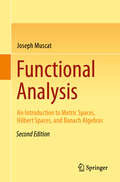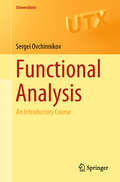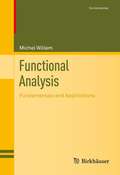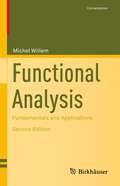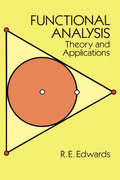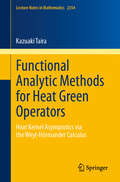- Table View
- List View
Functional Analysis and Applications (Industrial and Applied Mathematics #377)
by Abul Hasan SiddiqiThis self-contained textbook discusses all major topics in functional analysis. Combining classical materials with new methods, it supplies numerous relevant solved examples and problems and discusses the applications of functional analysis in diverse fields. The book is unique in its scope, and a variety of applications of functional analysis and operator-theoretic methods are devoted to each area of application. Each chapter includes a set of problems, some of which are routine and elementary, and some of which are more advanced. The book is primarily intended as a textbook for graduate and advanced undergraduate students in applied mathematics and engineering. It offers several attractive features making it ideally suited for courses on functional analysis intended to provide a basic introduction to the subject and the impact of functional analysis on applied and computational mathematics, nonlinear functional analysis and optimization. It introduces emerging topics like wavelets, Gabor system, inverse problems and application to signal and image processing.
Functional Analysis and Applied Optimization in Banach Spaces
by Fabio BotelhoThis book introduces the basic concepts of real and functional analysis. It presents the fundamentals of the calculus of variations, convex analysis, duality, and optimization that are necessary to develop applications to physics and engineering problems. The book includes introductory and advanced concepts in measure and integration, as well as an introduction to Sobolev spaces. The problems presented are nonlinear, with non-convex variational formulation. Notably, the primal global minima may not be attained in some situations, in which cases the solution of the dual problem corresponds to an appropriate weak cluster point of minimizing sequences for the primal one. Indeed, the dual approach more readily facilitates numerical computations for some of the selected models. While intended primarily for applied mathematicians, the text will also be of interest to engineers, physicists, and other researchers in related fields.
Functional Analysis and Continuous Optimization: In Honour of Juan Carlos Ferrando's 65th Birthday, Elche, Spain, June 16–17, 2022 (Springer Proceedings in Mathematics & Statistics #424)
by Manuel López-Pellicer José M. Amigó María J. Cánovas Marco A. López-CerdáThe book includes selected contributions presented at the "International Meeting on Functional Analysis and Continuous Optimization" held in Elche (Spain) on June 16–17, 2022. Its contents cover very recent results in functional analysis, continuous optimization and the interplay between these disciplines. Therefore, this book showcases current research on functional analysis and optimization with individual contributions, as well as new developments in both areas. As a result, the reader will find useful information and stimulating ideas.
Functional Analysis and Operator Algebras (CMS/CAIMS Books in Mathematics #13)
by Kenneth R. DavidsonThis book offers a comprehensive introduction to various aspects of functional analysis and operator algebras. In Part I, readers will find the foundational material suitable for a one-semester course on functional analysis and linear operators. Additionally, Part I includes enrichment topics that provide flexibility for instructors. Part II covers the fundamentals of Banach algebras and C*-algebras, followed by more advanced material on C* and von Neumann algebras. This section is suitable for use in graduate courses, with instructors having the option to select specific topics. Part III explores a range of important topics in operator theory and operator algebras. These include $H^p$ spaces, isometries and Toeplitz operators, nest algebras, dilation theory, applications to various classes of nonself-adjoint operator algebras, and noncommutative convexity and Choquet theory. This material is suitable for graduate courses and learning seminars, offering instructors flexibility in selecting topics.
Functional Analysis and Operator Theory (Problem Books in Mathematics)
by Alexander Kukush Yuliya Mishura Volodymyr Brayman Andrii Chaikovskyi Oleksii Konstantinov Oleksii NesterenkoThe book contains a collection of more than 800 problems from all main chapters of functional analysis, with theoretical background and solutions. It is mostly intended for undergraduate students who are starting to study the course of functional analysis. The book will also be useful for graduate and post- graduate students and researchers who wish to refresh their knowledge and deepen their understanding of the subject, as well as for teachers of functional analysis and related disciplines. It can be used for independent study as well. It is assumed that the reader has mastered standard courses of calculus and measure theory and has basic knowledge of linear algebra, analytic geometry, and differential equations. This collection of problems can help students of different levels of training and different areas of specialization to learn how to solve problems in functional analysis. Each chapter of the book has similar structure and consists of the following sections: Theoretical Background, Examples of Problems with Solutions, and Problems to Solve. The book contains theoretical preliminaries to ensure that the reader understands the statements of problems and is able to successfully solve them. Then examples of typical problems with detailed solutions are included, and this is relevant not only for those students who have significant difficulties in studying this subject, but also for other students who due to various circumstances сcould be deprived of communication with a teacher. There are problems for independent solving, and the corresponding selection of problems reflects all the main plot lines that relate to a given topic. The number of problems is sufficient both for a teacher to give practical lessons, to set homework, to prepare tasks for various forms of control, and for those students who want to study the discipline more deeply. Problems of a computational nature are provided with answers, while theoretical problems, the solutions ofwhich require non-trivial ideas or new techniques, are provided with detailed hints or solutions to introduce the reader to the corresponding ideas or techniques.
Functional Analysis and Optimization Methods in Hadron Physics (SpringerBriefs in Physics)
by Irinel CapriniThis book begins with a brief historical review of the early applications of standard dispersion relations in particle physics. It then presents the modern perspective within the Standard Model, emphasizing the relation of analyticity together with alternative tools applied to strong interactions, such as perturbative and lattice quantum chromodynamics (QCD), as well as chiral perturbation theory. The core of the book argues that, in order to improve the prediction of specific hadronic observables, it is often necessary to resort to methods of complex analysis more sophisticated than the simple Cauchy integral. Accordingly, a separate mathematical chapter is devoted to solving several functional analysis optimization problems. Their applications to physical amplitudes and form factors are discussed in the following chapters, which also demonstrate how to merge the analytic approach with statistical analysis tools. Given its scope, the book offers a valuable guide for researchers working in precision hadronic physics, as well as graduate students who are new to the field.
Functional Analysis and Summability
by P.N. NatarajanThere are excellent books on both functional analysis and summability. Most of them are very terse. In Functional Analysis and Summability, the author makes a sincere attempt for a gentle introduction of these topics to students. In the functional analysis component of the book, the Hahn–Banach theorem, Banach–Steinhaus theorem (or uniform boundedness principle), the open mapping theorem, the closed graph theorem, and the Riesz representation theorem are highlighted. In the summability component of the book, the Silverman–Toeplitz theorem, Schur’s theorem, the Steinhaus theorem, and the Steinhaus-type theorems are proved. The utility of functional analytic tools like the uniform boundedness principle to prove some results in summability theory is also pointed out. Features A gentle introduction of the topics to the students is attempted. Basic results of functional analysis and summability theory and their applications are highlighted. Many examples are provided in the text. Each chapter ends with useful exercises. This book will be useful to postgraduate students, pre-research level students, and research scholars in mathematics. Students of physics and engineering will also find this book useful since topics in the book also have applications in related areas.
Functional Analysis and Valuation Theory (Chapman & Hall/CRC Pure and Applied Mathematics)
by Lawrence NariciThis book presents functional analysis over arbitrary valued fields and investigates normed spaces and algebras over fields with valuation, with attention given to the case when the norm and the valuation are nonarchimedean. It considers vector spaces over fields with nonarchimedean valuation.
Functional Analysis and the Feynman Operator Calculus
by Tepper L. Gill Woodford W. ZacharyThis book provides the mathematical foundations forFeynman's operator calculus and for the Feynman path integral formulation ofquantum mechanics as a natural extension of analysis and functional analysis tothe infinite-dimensional setting. In one application, the resultsare used to prove the last two remaining conjectures of Freeman Dyson forquantum electrodynamics. In another application, the results are used tounify methods and weaken domain requirements for non-autonomous evolutionequations. Other applications include a general theory of Lebesguemeasure on Banach spaces with a Schauder basis and a new approach to thestructure theory of operators on uniformly convex Banach spaces. This book isintended for advanced graduate students and researchers.
Functional Analysis for the Applied Mathematician (Textbooks in Mathematics)
by Todd Arbogast Jerry L. BonaFunctional Analysis for the Applied Mathematician is a self-contained volume providing a rigorous introduction to functional analysis and its applications. Students from mathematics, science, engineering, and certain social science and interdisciplinary programs will benefit from the material. It is accessible to graduate and advanced undergraduate students with a solid background in undergraduate mathematics and an appreciation of mathematical rigor. Students are called upon to actively engage with the material, to the point of proving some of the basic results or their straightforward generalizations, both within the text and within the generous set of exercises.Features: Replete with exercises and examples Suitable for graduate students and advanced undergraduates Develops the basics of functional analysis, exploring the interplay between algebraic linear space theory and topology Presents a variety of applications, often dealing with partial differential equations and their numerical approximation Doubles as a reference book with an extensive index listing the concepts and results
Functional Analysis for the Applied Sciences (Universitext)
by Gheorghe MoroşanuThis advanced graduate textbook presents main results and techniques in Functional Analysis and uses them to explore other areas of mathematics and applications. Special attention is paid to creating appropriate frameworks towards solving significant problems involving differential and integral equations. Exercises at the end of each chapter help the reader to understand the richness of ideas and methods offered by Functional Analysis. Some of the exercises supplement theoretical material, while others relate to the real world. This textbook, with its friendly exposition, focuses on different problems in physics and other applied sciences and uniquely provides solutions to most of the exercises. The text is aimed toward graduate students and researchers in applied mathematics, physics, and neighboring fields of science.
Functional Analysis in Applied Mathematics and Engineering (Studies In Advanced Mathematics Ser. #31)
by Michael PedersenPresenting excellent material for a first course on functional analysis , Functional Analysis in Applied Mathematics and Engineering concentrates on material that will be useful to control engineers from the disciplines of electrical, mechanical, and aerospace engineering.This text/reference discusses:rudimentary topologyBanach's fixed point theorem with applicationsL^p-spacesdensity theorems for testfunctionsinfinite dimensional spacesbounded linear operatorsFourier seriesopen mapping and closed graph theoremscompact and differential operatorsHilbert-Schmidt operatorsVolterra equationsSobolev spacescontrol theory and variational analysisHilbert Uniqueness Methodboundary element methodsFunctional Analysis in Applied Mathematics and Engineering begins with an introduction to the important, abstract basic function spaces and operators with mathematical rigor, then studies problems in the Hilbert space setting. The author proves the spectral theorem for unbounded operators with compact inverses and goes on to present the abstract evolution semigroup theory for time dependent linear partial differential operators. This structure establishes a firm foundation for the more advanced topics discussed later in the text.
Functional Analysis in Interdisciplinary Applications
by Michael V. Ruzhansky Tynysbek Sh. Kalmenov Erlan D. Nursultanov Makhmud A. SadybekovThis volume presents current research in functional analysis and its applications to a variety of problems in mathematics and mathematical physics. The book contains over forty carefully refereed contributions to the conference "Functional Analysis in Interdisciplinary Applications" (Astana, Kazakhstan, October 2017). Topics covered include the theory of functions and functional spaces; differential equations and boundary value problems; the relationship between differential equations, integral operators and spectral theory; and mathematical methods in physical sciences. Presenting a wide range of topics and results, this book will appeal to anyone working in the subject area, including researchers and students interested to learn more about different aspects and applications of functional analysis.
Functional Analysis in Interdisciplinary Applications—II: ICAAM, Lefkosa, Cyprus, September 6–9, 2018 (Springer Proceedings in Mathematics & Statistics #351)
by Michael V. Ruzhansky Tynysbek Sh. Kalmenov Makhmud A. Sadybekov Durvudkhan Suragan Allaberen AshyralyevFunctional analysis is an important branch of mathematical analysis which deals with the transformations of functions and their algebraic and topological properties. Motivated by their large applicability to real life problems, applications of functional analysis have been the aim of an intensive study effort in the last decades, yielding significant progress in the theory of functions and functional spaces, differential and difference equations and boundary value problems, differential and integral operators and spectral theory, and mathematical methods in physical and engineering sciences. The present volume is devoted to these investigations. The publication of this collection of papers is based on the materials of the mini-symposium "Functional Analysis in Interdisciplinary Applications" organized in the framework of the Fourth International Conference on Analysis and Applied Mathematics (ICAAM 2018, September 6–9, 2018). Presenting a wide range of topics and results, this book will appeal to anyone working in the subject area, including researchers and students interested to learn more about different aspects and applications of functional analysis. Many articles are written by experts from around the world, strengthening international integration in the fields covered. The contributions to the volume, all peer reviewed, contain numerous new results.This volume contains four different chapters. The first chapter contains the contributed papers focusing on various aspects of the theory of functions and functional spaces. The second chapter is devoted to the research on difference and differential equations and boundary value problems. The third chapter contains the results of studies on differential and integral operators and on the spectral theory. The fourth chapter is focused on the simulation of problems arising in real-world applications of applied sciences.
Functional Analysis, Calculus of Variations and Numerical Methods for Models in Physics and Engineering
by Fabio Silva BotelhoThe book discusses basic concepts of functional analysis, measure and integration theory, calculus of variations and duality and its applications to variational problems of non-convex nature, such as the Ginzburg-Landau system in superconductivity, shape optimization models, dual variational formulations for micro-magnetism and others. Numerical Methods for such and similar problems, such as models in flight mechanics and the Navier-Stokes system in fluid mechanics have been developed through the generalized method of lines, including their matrix finite dimensional approximations. It concludes with a review of recent research on Riemannian geometry applied to Quantum Mechanics and Relativity. The book will be of interest to applied mathematicians and graduate students in applied mathematics. Physicists, engineers and researchers in related fields will also find the book useful in providing a mathematical background applicable to their respective professional areas.
Functional Analysis, Calculus of Variations and Optimal Control
by Francis ClarkeFunctional analysis owes much of its early impetus to problems that arise in the calculus of variations. In turn, the methods developed there have been applied to optimal control, an area that also requires new tools, such as nonsmooth analysis. This self-contained textbook gives a complete course on all these topics. It is written by a leading specialist who is also a noted expositor. This book provides a thorough introduction to functional analysis and includes many novel elements as well as the standard topics. A short course on nonsmooth analysis and geometry completes the first half of the book whilst the second half concerns the calculus of variations and optimal control. The author provides a comprehensive course on these subjects, from their inception through to the present. A notable feature is the inclusion of recent, unifying developments on regularity, multiplier rules, and the Pontryagin maximum principle, which appear here for the first time in a textbook. Other major themes include existence and Hamilton-Jacobi methods. The many substantial examples, and the more than three hundred exercises, treat such topics as viscosity solutions, nonsmooth Lagrangians, the logarithmic Sobolev inequality, periodic trajectories, and systems theory. They also touch lightly upon several fields of application: mechanics, economics, resources, finance, control engineering. Functional Analysis, Calculus of Variations and Optimal Control is intended to support several different courses at the first-year or second-year graduate level, on functional analysis, on the calculus of variations and optimal control, or on some combination. For this reason, it has been organized with customization in mind. The text also has considerable value as a reference. Besides its advanced results in the calculus of variations and optimal control, its polished presentation of certain other topics (for example convex analysis, measurable selections, metric regularity, and nonsmooth analysis) will be appreciated by researchers in these and related fields.
Functional Analysis, Holomorphy, and Approximation Theory (Lecture Notes In Pure And Applied Mathematics Ser. #83)
by Guido I. ZapataThis book contains papers on complex analysis, function spaces, harmonic analysis, and operators, presented at the International seminar on Functional Analysis, Holomorphy, and Approximation Theory held in 1979. It is addressed to mathematicians and advanced graduate students in mathematics.
Functional Analysis, Sobolev Spaces, and Calculus of Variations (UNITEXT #157)
by Pablo PedregalThis book aims at introducing students into the modern analytical foundations to treat problems and situations in the Calculus of Variations solidly and rigorously. Since no background is taken for granted or assumed, as the textbook pretends to be self-contained, areas like basic Functional Analysis and Sobolev spaces are studied to the point that chapters devoted to these topics can be utilized by themselves as an introduction to these important parts of Analysis. The material in this regard has been selected to serve the needs of classical variational problems, leaving broader treatments for more advanced and specialized courses in those areas. It should not be forgotten that problems in the Calculus of Variations historically played a crucial role in pushing Functional Analysis as a discipline on its own right. The style is intentionally didactic. After a first general chapter to place optimization problems in infinite-dimensional spaces in perspective, the first part of the book focuses on the initial important concepts in Functional Analysis and introduces Sobolev spaces in dimension one as a preliminary, simpler case (much in the same way as in the successful book of H. Brezis). Once the analytical framework is covered, one-dimensional variational problems are examined in detail including numerous examples and exercises. The second part dwells, again as a first-round, on another important chapter of Functional Analysis that students should be exposed to, and that eventually will find some applications in subsequent chapters. The first chapter of this part examines continuous operators and the important principles associated with mappings between functional spaces; and another one focuses on compact operators and their fundamental and remarkable properties for Analysis. Finally, the third part advances to multi-dimensional Sobolev spaces and the corresponding problems in the Calculus of Variations. In this setting, problems become much more involved and, for this same reason, much more interesting and appealing. In particular, the final chapter dives into a number of advanced topics, some of which reflect a personal taste. Other possibilities stressing other kinds of problems are possible. In summary, the text pretends to help students with their first exposure to the modern calculus of variations and the analytical foundation associated with it. In particular, it covers an extended introduction to basic functional analysis and to Sobolev spaces. The tone of the text and the set of proposed exercises will facilitate progressive understanding until the need for further challenges beyond the topics addressed here will push students to more advanced horizons.
Functional Analysis: An Introduction to Metric Spaces, Hilbert Spaces, and Banach Algebras
by Joseph MuscatThis textbook provides an introduction to functional analysis suitable for lecture courses to final year undergraduates or beginning graduates.Starting from the very basics of metric spaces, the book adopts a self-contained approach to Banach spaces and operator theory that covers the main topics, including the spectral theorem, the Gelfand transform, and Banach algebras. Various applications, such as least squares approximation, inverse problems, and Tikhonov regularization, illustrate the theory. Over 1000 worked examples and exercises of varying difficulty present the reader with ample material for reflection.This new edition of Functional Analysis has been completely revised and corrected, with many passages rewritten for clarity, numerous arguments simplified, and a good amount of new material added, including new examples and exercises. The prerequisites, however, remain the same with only knowledge of linear algebra and real analysis of a singlevariable assumed of the reader.
Functional Analysis: An Introductory Course (Universitext)
by Sergei OvchinnikovThis concise text provides a gentle introduction to functional analysis. Chapters cover essential topics such as special spaces, normed spaces, linear functionals, and Hilbert spaces. Numerous examples and counterexamples aid in the understanding of key concepts, while exercises at the end of each chapter provide ample opportunities for practice with the material. Proofs of theorems such as the Uniform Bounded Theory, the Open Mapping Theorem, and the Closed Graph Theorem are worked through step-by-step, providing an accessible avenue to understanding these important results. The prerequisites for this book are linear algebra and elementary real analysis, with two introductory chapters providing an overview of material necessary for the subsequent text. Functional Analysis offers an elementary approach ideal for the upper-undergraduate or beginning graduate student. Primarily intended for a one-semester introductory course, this text is also a perfect resource for independent study or as the basis for a reading course.
Functional Analysis: Fundamentals and Applications
by Michel WillemThe goal of this work is to present the principles of functional analysis in a clear and concise way. The first three chapters of Functional Analysis: Fundamentals and Applications describe the general notions of distance, integral and norm, as well as their relations. The three chapters that follow deal with fundamental examples: Lebesgue spaces, dual spaces and Sobolev spaces. Two subsequent chapters develop applications to capacity theory and elliptic problems. In particular, the isoperimetric inequality and the Pólya-Szegő and Faber-Krahn inequalities are proved by purely functional methods. The epilogue contains a sketch of the history of functional analysis, in relation with integration and differentiation. Starting from elementary analysis and introducing relevant recent research, this work is an excellent resource for students in mathematics and applied mathematics.
Functional Analysis: Fundamentals and Applications (Cornerstones)
by Michel WillemThis textbook presents the principles of functional analysis in a clear and concise way. The first three chapters describe the general notions of distance, integral, and norm, as well as their relations. Fundamental examples are provided in the three chapters that follow: Lebesgue spaces, dual spaces, and Sobolev spaces. Two subsequent chapters develop applications to capacity theory and elliptic problems. In particular, the isoperimetric inequality and the Pólya-Szegő and Faber-Krahn inequalities are proved by purely functional methods. The epilogue contains a sketch of the history of functional analysis in relation to integration and differentiation. Starting from elementary analysis and introducing relevant research, this work is an excellent resource for students in mathematics and applied mathematics. The second edition of Functional Analysis includes several improvements as well as the addition of supplementary material. Specifically, the coverage of advanced calculus and distribution theory has been completely rewritten and expanded. New proofs, theorems, and applications have been added as well for readers to explore.
Functional Analysis: Introduction to Further Topics in Analysis
by Elias M. Stein Rami ShakarchiThis is the fourth and final volume in the Princeton Lectures in Analysis, a series of textbooks that aim to present, in an integrated manner, the core areas of analysis. Beginning with the basic facts of functional analysis, this volume looks at Banach spaces, Lp spaces, and distribution theory, and highlights their roles in harmonic analysis. The authors then use the Baire category theorem to illustrate several points, including the existence of Besicovitch sets. The second half of the book introduces readers to other central topics in analysis, such as probability theory and Brownian motion, which culminates in the solution of Dirichlet's problem. The concluding chapters explore several complex variables and oscillatory integrals in Fourier analysis, and illustrate applications to such diverse areas as nonlinear dispersion equations and the problem of counting lattice points. Throughout the book, the authors focus on key results in each area and stress the organic unity of the subject. A comprehensive and authoritative text that treats some of the main topics of modern analysis A look at basic functional analysis and its applications in harmonic analysis, probability theory, and several complex variables Key results in each area discussed in relation to other areas of mathematics Highlights the organic unity of large areas of analysis traditionally split into subfields Interesting exercises and problems illustrate ideas Clear proofs provided
Functional Analysis: Theory and Applications
by R. E. Edwards"The book contains an enormous amount of information -- mathematical, bibliographical and historical -- interwoven with some outstanding heuristic discussions." -- Mathematical Reviews.In this massive graduate-level study, Emeritus Professor Edwards (Australian National University, Canberra) presents a balanced account of both the abstract theory and the applications of linear functional analysis. Written for readers with a basic knowledge of set theory, general topology, and vector spaces, the book includes an abundance of carefully chosen illustrative examples and excellent exercises at the end of each chapter.Beginning with a chapter of preliminaries on set theory and topology, Dr. Edwards then presents detailed, in-depth discussions of vector spaces and topological vector spaces, the Hahn-Banach theorem (including applications to potential theory, approximation theory, game theory, and other fields) and fixed-point theorems. Subsequent chapters focus on topological duals of certain spaces: radon measures, distribution and linear partial differential equations, open mapping and closed graph theorems, boundedness principles, duality theory, the theory of compact operators and the Krein-Milman theorem and its applications to commutative harmonic analysis. Clearly and concisely written, Dr. Edwards's book offers rewarding reading to mathematicians and physicists with an interest in the important field of functional analysis. Because of the broad scope of its coverage, this volume will be especially valuable to the reader with a basic knowledge of functional analysis who wishes to learn about parts of the subject other than his own specialties. A comprehensive 32-page bibliography supplies a rich source of references to the basic literature.
Functional Analytic Methods for Heat Green Operators: Heat Kernel Asymptotics via the Weyl-Hörmander Calculus (Lecture Notes in Mathematics #2354)
by Kazuaki TairaThis monograph guides the reader to the mathematical crossroads of heat equations and differential geometry via functional analysis. Following the recent trend towards constructive methods in the theory of partial differential equations, it makes extensive use of the ideas and techniques from the Weyl–Hörmander calculus of pseudo-differential operators to study heat Green operators through concrete calculations for the Dirichlet, Neumann, regular Robin and hypoelliptic Robin boundary conditions. Further, it provides detailed coverage of important examples and applications in elliptic and parabolic problems, illustrated with many figures and tables. A unified mathematical treatment for solving initial boundary value problems for the heat equation under general Robin boundary conditions is desirable, and leads to an extensive study of various aspects of elliptic and parabolic partial differential equations. The principal ideas are explicitly presented so that a broad spectrum of readers can easily understand the problem and the main results. The book will be of interest to readers looking for a functional analytic introduction to the meeting point of partial differential equations, differential geometry and probability.
